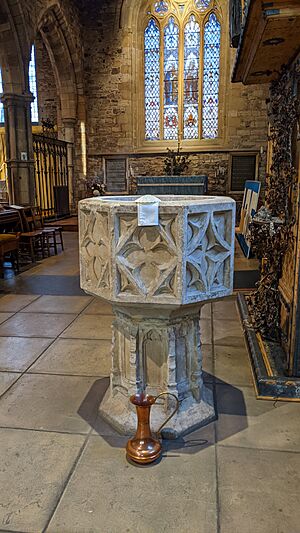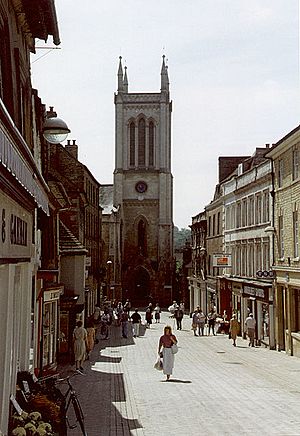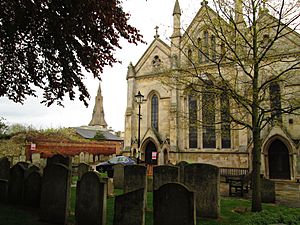Church of St Michael the Greater, Stamford facts for kids
The Church of St Michael the Greater is an old church in Stamford, Lincolnshire. It was built in a style called Gothic Revival, which was popular in the late Georgian period. This church stands on the south side of Stamford High Street. It was built on the same spot where an even older church from the Medieval times used to be. The church building is officially recognized as a Grade II listed building. This means it is an important historical building that needs to be protected. The wall around the churchyard is also a separate Grade II listed structure.
The church was named St Michael the Greater to tell it apart from another church in Stamford called 'St Michael in Cornstall'.
Contents
History of the Church Building
Early Beginnings and Medieval Times
The location of the church, right in the middle of the old medieval town, suggests it was built a very long time ago. It might even have been founded before the Normans came to England in 1066. We know for sure that by the mid-1100s, the church was owned by Crowland Abbey. It's possible that Crowland Abbey itself founded St Michael's.
The medieval church had a main area called a nave, with side sections called aisles. It also had a chancel and smaller chapels. This church was often used for important meetings in medieval Stamford. These meetings included church courts and town council gatherings. The building was changed a lot in the 1400s and again in the 1600s. At that time, its tower was made of wood. In 1761, the wooden tower was replaced with a stone one.
Collapse and Rebuilding
Sadly, the church building collapsed in 1832. This happened after the Rector, Reverend Charles Swan, removed some of the pillars inside the main part of the church. He reportedly did this to make the church look better.
The church you see today was designed by John Brown from Norwich. It was built between 1835 and 1836 using Ketton stone. The new church was built in a style similar to the Early English style. Its design was inspired by the Lady Chapel of Salisbury Cathedral. The local newspaper, the Stamford Mercury, praised the new building a lot.
The new church had a square tower at the west end. It also had iron railings around its outside and many galleries and pews inside. The builders were Woolston and Collins. The original plan in 1834 estimated the cost to be £2,800. However, by the time it opened in 1836, the total cost was £4,000. From the old medieval church, only two stone pieces, possibly from the 1200s, survived. These are found in a small room under the west tower.
Life After Being a Church
Becoming Shops

The Church of St Michael the Greater stopped being used as a church in 1974. For several years, people discussed what to do with it. Some even thought about tearing it down. Finally, in 1982, it was decided to turn the building into shops.
The company Arthur Mull Associates from Huntingdon managed this change. The famous architectural historian Nikolaus Pevsner described the conversion as "unsympathetic" and "appalling." The inside of the church was completely changed and divided up. Its old plasterwork and stained-glass windows were removed.
What Happened to Church Items?
Many items from the church were moved or sold. A special stone basin called a font, which was from the 1400s, was sent to St Nicholas Church, Leicester. A set of bells from the 1700s and some silver church items from the 1600s were also moved to different places. The organ, which was built by J. W. Walker & Sons Ltd in 1863, was moved to St Mark's church in Killylea, Co. Armagh, in 1967.
Changes to the Building and Churchyard
Six large shop windows were added to the north wall of the building. The shopping areas now extend to the back of the building on the ground floor. The rest of the space is used for storage. A car park and delivery area were built at the back, which flattened much of the old medieval churchyard.
However, some old tombstones and memorials from the 1700s and 1800s still remain. There is also a special chest tomb from the late 1600s. Even these remaining parts of the churchyard have faced threats of new buildings being built on them over the years.
The churchyard is still looked after by South Kesteven District Council. In the 2000s, a memorial for the Holocaust was added there. In 2016, new gates with the Stamford town symbols were put in place.



